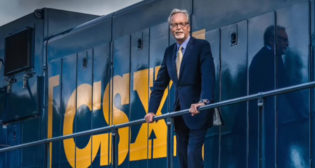
Whether the stumbles are self-inflicted is secondary to the CSX commitment to recover, as the speed and quality of that recovery will spell the measure of current management to meet Job No. 1 of every transportation firm: Deliver a customer’s product where it is wanted, when it is wanted, without damage and at a reasonable price.
World-class customer service, not an emphasis on short-term earnings as if CSX were Bitcoin, is the time-honored method to raise and stabilize stock price and stock dividend.
As widely reported, CSX underwent a hedge-fund-influenced management transfer in early 2017 with the arrival of President and CEO E. Hunter Harrison, legendary for reducing operating costs and boosting profits on three mostly linear railroads—Illinois Central, CN and Canadian Pacific (CP).
Spaghetti-like CSX is neither a linear railroad nor one whose unit-train business substantially exceeds single cars as is the case on CN and CP. Thus, the challenge of implementing the Harrison-branded “Precision Scheduled Railroading” was presumed as somewhere between the agony of Sisyphus and safely navigating the strait separating Scylla and Charybdis.
In optimistic anticipation of a prefigured larger-than-life Harrison transforming CSX into the envy of modern railroading, no matter the warnings, investors propelled upward the CSX stock price—albeit in roller-coaster fashion and with more than a dollop of speculative fervor. CSX customers and rail labor leaders have not been so smitten.
Following Harrison’s arrival, CSX shippers complained of closed classification yards; longer transit times; unreliable car service; circuitous routings with “ping-ponging” of their loaded freight cars across the railroad’s extensive East Coast network; and dreadful communications. Those lacking effective transportation alternatives complained of rate increases in the midst of service degradation. Harrison said it was all part of his quest to implement Precision Scheduled Railroading.
Labor leaders said CSX had lowered the bar for worker safety, citing excessive train length (now under investigation by the Government Accountability Office, Federal Railroad Administration and Surface Transportation Board); mandated shortcuts in methods of securing trains in yards and terminals; increased yard speed limits; a requirement that crews board and exit moving trains to save time; and the shedding of 12% of the workforce in 2017, with another 2,000 said to be on the chopping block in 2018. One union president accused CSX of launching “a personal attack” on workers. At CN, union workers referred to Harrison as “the ugly American” for his alleged cavalier attitude toward work rules.
A variety of other interests, including safety regulators and officers of other railroads, speak of “a gutting [at CSX] of corporate culture with unknown future impact,” and “the hollowing out of institutional knowledge” that includes the departure of 20 senior officers, including Vice President Operations Cindy Sanborn (quickly recruited by Union Pacific as a regional vice president and said to be on a fast track to higher office there).
When the STB—in receipt of complaints from members of Congress, rail labor organizations and aggrieved shippers—convened an oversight hearing Oct.11 (politely called a “listening session”), Harrison testified that CSX service problems could be a result of too-rapid implementation of Precision Scheduled Railroading, and that “you wouldn’t want to start at any company with a proxy battle.”
Saying that Precision Scheduled Railroading means “having to do more with less,” Harrison placed additional blame on the CSX workforce, complaining of their “resistance to change.”
Harrison’s strongest words were directed at CSX customers, especially the Rail Customer Coalition, an umbrella organization for dozens of associations representing hundreds of diverse shippers (including agriculture, automotive, chemicals, coal, manufacturing and electric utilities)—many large and politically powerful.
In an Aug. 16 letter he signed, Harrison termed shipper complaints of “chronic service failures” as “unfounded and grossly overstated.” He continued, “Since coalitions do not have service issues, we do not intend to continue a discussion with you about the service we provide to our customers.” Harrison sent copies to the chairmen of the House and Senate committees with railroad oversight.
The tone of that letter has created concern within the railroad industry. In fact, the members of that shipper coalition disparaged by Harrison include those who formerly comprised Consumers United for Rail Equity (CURE), which aggressively promoted a roll-back of the partial economic deregulation afforded railroads by Congress in 1980 (via the Staggers Rail Act). The defense against reregulation legislation—at times a near-run thing—cost the railroad industry millions of dollars in lobbying and other expenses. And the threat of reregulation remains.
Following Harrison’s death in December, the CSX board named as Harrison’s successor his disciple and confidant, James M. Foote, whose well-respected, four-decade rail background is primarily in marketing, sales, investor relations, labor relations, communications and law.
Foote, recognizing his limitations, brought aboard Edmund L. Harris as operations chief, another former Harrison confidant and assiduous student of Harrison’s Precision Scheduled Railroading. Harris was a consultant to The Children’s Investment Fund during the late 1990s when that hedge fund unsuccessfully attempted a hostile takeover of CSX. AT CN and CP, Harris had benefit of a highly trained middle-management with substantial institutional knowledge. Harrison is said to have hollowed that out at CSX during 2017.
While Foote now speaks of “a remarkable rate of positive change” at CSX, shippers continue to cite service failures in communication with lawmakers and regulators. During a meeting last week with STB officials, Railway Age was told that Foote, as with Harrison, “also had trouble accepting responsibility [for service failures] on behalf of CSX. He acknowledged CSX moved too fast, but definitely doesn’t acknowledge that CSX continues to do a poor job communicating.”
This all leads us to Congress, where notwithstanding tempestuous polarization, there is always bipartisan interest in safety issues, which rail labor organizations, for one, are eager to advance.
The House Rail Subcommittee will hold an oversight hearing Feb. 15 on Positive Train Control, which Amtrak President Richard H. Anderson said Feb. 4 could have prevented the South Carolina collision on CSX track.
While there is absolutely no correlation between that CSX-Amtrak accident Feb. 4—the cause and responsibility for which can only be determined by a National Transportation Safety Board (NTSB) investigation—and the Feb. 15 hearing on PTC, lawmakers of all political stripes cherish opportunities in election years to be on camera in support of safety, a completed NTSB investigation or not.
The STB, meanwhile, may be independent, but its funding comes from Congress, and its members require Senate confirmation. And the FRA is an agency of the Executive Branch Department of Transportation, whose Cabinet Secretary, Elaine Chao, is the spouse of Senate Majority Leader Mitch McConnell.
It should be enough to say that sharp sticks needlessly poking at the eyes of politically powerful shippers and labor organizations is its own train wreck waiting to happen.
It would be wise for the expatriate top CSX management, now returned from a long tenure in Canada, to reread, mark and inwardly digest the American political and regulatory process and atmosphere.
Rail labor and captive rail shippers previously aligned against freight railroads darn-near ignited Congress to reregulate the industry—and it could happen again. As author and Nobel Prize laureate William Faulkner wrote, “The past is not dead. In fact, it’s not even past.”




